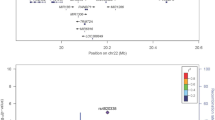Abstract.
Familial clustering and linkage disequilibrium studies suggest that genetic factors predispose to vitiligo, although a clear transmission pattern and cosegregation of vitiligo with specific mutations have not been demonstrated. We collected pedigree data on vitiligo from a set of 56 multigeneration families belonging to the Paisa community from Antioquia, with the goal of applying the unified model of complex segregation and linkage disequilibrium analyses to test the hypotheses of the existence of a major gene predisposing to vitiligo and that allelic or haplotype polymorphisms of microsatellite loci at 6p21.3–21.4 spanning HLA (D6S276, D6S265, D6S273, and D6S291) are associated with this predisposition. Minimum sibship sample size to discriminate dominant and recessive inheritance models was largely accomplished. Between the 15 models of complex segregation used, the one that best fitted the data was that of a major dominant gene and the existence of strong environmental effects acting on the recessive genotype. The penetrance and risk estimations discriminated two sets of vitiligo patients: those with early onset of vitiligo cosegregating with a dominant mode of inheritance without environmental effects, and those with late onset of vitiligo cosegregating with the recessive genotype and being influenced by environmental effects. After establishing the normal distribution of allelic frequencies and performing multiple comparisons correction, the linkage disequilibrium analysis suggested that a major genetic factor could be located at 6p21.3–21.4, because we detected significant case-control differences for allele 122 at D6S265 (Pc=0.0264) and significant linkage disequilibrium between loci D6S276 and D6S273 in the cases but not in the controls. We cannot explain these results as a consequence of evolutionary forces or as genetic stratification acting differentially on cases and controls, because there was neither deviation from the Hardy-Weinberg expectations nor genetic subdivision between cases and controls, as θ (non-biased FST) was not significantly different from 0.
Similar content being viewed by others
Author information
Authors and Affiliations
Additional information
Electronic Publication
Rights and permissions
About this article
Cite this article
Arcos-Burgos, M., Parodi, E., Salgar, M. et al. Vitiligo: complex segregation and linkage disequilibrium analyses with respect to microsatellite loci spanning the HLA. Hum Genet 110, 334–342 (2002). https://doi.org/10.1007/s00439-002-0687-5
Received:
Accepted:
Published:
Issue Date:
DOI: https://doi.org/10.1007/s00439-002-0687-5




